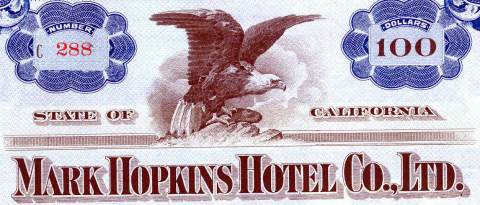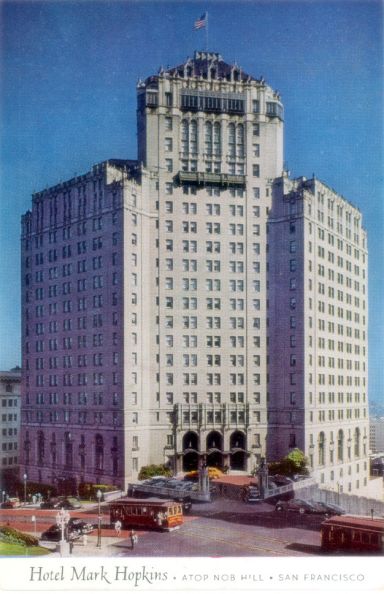Beautifully engraved certificate from the Mark Hopkins Hotel Co. issued in 1930. This historic document has an ornate border around it with a vignette of an eagle. This item is hand signed by the Company's President and founder ( George D. Smith ) and is over 83 years old. 
Certificate Vignette 
Hotel Picture - Named after Mark Hopkins, the founder of the Central Pacific Railroad, The Mark Hopkins Hotel opened 1926. The 25-story Mark Hopkins Hotel, across the street from the Hotel Fairmont, was completed in 1925. This is one of the most famous hotels in San Francisco, and the Top of the Mark, the glass-walled bar on the 19th floor, is the most celebrated of the city's drinking establishments. The Mark Hopkins rests atop Nob Hill, and the view of the city from the Top of the Mark has been drawing locals and visitors for 75 years. In 1939, owner George D. Smith converted the 19th floor penthouse into a glass-walled cocktail lounge with a 360 degree view of the city below. It was an immediate success. George D. Smith was also involved with the Golden Gate International Exposition at Treasure island. 1878 - The original Mark Hopkins mansion is completed on Nob Hill (after the death of Mark Hopkins). The 40-room house resembled a fabulous, Gothic-style palace, bristling with spires, gables, and a profusion of "gingerbread" ornamentation. Mark Hopkins was a founder of the Central Pacific railroad. 1879 - Robert Louis Stevenson visits San Francisco, declaring that "Nob Hill, the Hill of Palaces, must certainly be counted the best part of San Francisco." Of the palatial homes on Nob Hill built by magnates such as Stanford, Crocker and Huntington, none was grander than the gabled Victorian mansion of Mark Hopkins. 1891 - Mrs Mark Hopkins dies, leaving the Nob Hill mansion and a $70-million estate to her second husband, Edward T Searles. 1893 - Searles donates the mansion to the San Francisco Art Association (now San Francisco Art Institute) to be used as a school and a museum. 1906 - The San Francisco earthquake and fire destroys the Mark Hopkins mansion, leaving only the chimney stacks and granite retaining wall. Ironically, it was discovered too late that a half-million gallon water reservoir existed beneath the structure. The Art Association constructs a more modest structure on the mansion's foundations. 1925 - Mining engineer and hotel investor George D Smith purchases the Nob Hill site, removes the Art Association building and begins construction of a luxury hotel. Designed by the San Francisco architects Peter Weeks and William P Day, the 19-story hotel's architecture is a combination of French château and Spanish Renaissance, embellished with elaborate terracotta ornamentation. Because the hotel consists of a tall, central tower and two outstretched wings, each guest room offers a spectacular view of San Francisco Bay, the city, the surrounding hills, and the ocean. 1926 - The Mark Hopkins Hotel opens on 4th December. San Franciscans proclaim it "architecturally perfect, flawless in its erection, comprehensive in its accommodations... strikingly representative of the best there is in modern hostelry". 1929 D.M. Linnard had a chain of hotels in California. In 1929, he sold the Fairmont to George Smith, a mining engineer, who had just completed the Mark Hopkins Hotel. Smith undertook a major renovation, including adding an indoor pool, the 'Fairmont Plunge.' 1945 - The Mark Hopkins Hotel is the site of the historic meetings for the founding of the United Nations. 1962 - The Mark Hopkins Hotel is sold by original owner George D Smith to San Francisco financier Louis Lurie. 1973 - Lurie's heirs sign a long-term management contract for the Mark Hopkins with Inter-Continental Hotels Corporation. 1982 - Inter-Continental Hotels completes a $12-million, three-year renovation of the Mark Hopkins Inter-Continental, including the restoration of the landmark facade and its elaborate ornamentation, redecoration of the Lobby and all public rooms, redecoration of the guest rooms, and installation or upgrading of all mechanical and safety systems. 1988 - A major renovation of the Mark Hopkins Inter-Continental includes the Lobby, Lower Lobby Bar, Nob Hill Restaurant, and all 382 guest rooms and suites. Necessary improvements were made in order to enhance the look of the Mark while maintaining the traditional style and quality service for which it is revered. 1992 - The Mark Hopkins updates guest rooms with an elegant combination of new bedspreads, curtains, and chairs. Further improvements and renovations are made to the Lobby. 1993 - Lower Lobby Bar project is complete. Showcased under Tiffany-styled skylights, the newly renovated Lobby Bar stands alone in all its beauty. Tailored after an elegant indoor garden, the warm, mustard golds and terracotta colors radiate under the light throughout the room. In order to enhance their magnificent guest security system, The Mark installs new locks in all guest rooms. 1994 - The Mark Hopkins embarks on an unprecedented project: the renovation of the famous Peacock Court, the Room of The Dons, Florentine and Garden Rooms. 1995 - The highly anticipated Mark Hopkins unveiling marks the historic renovation of the Peacock Court and Room of The Dons. Highlighted by a dazzling display of intricate colors and design, the Peacock Court's impressive ceiling holds its esteemed place as the focal point of the Ballroom. Inspired by the ceiling, the room has been designed in rich colors of blue and beige with a custom-woven carpet that mirrors the exact pattern of the ceiling. History from Mark Hopkins Hotel press Information.
News Article form the San Francisco Chronicle Saturday, December 23, 1939 When Ned Greenway moved his debutante parties up to The Fairmont, it quickly became the social hub of the City. Wealthy families, displaced by the earthquake, took up residence, some for many years. Meanwhile, the Law brothers had signed a ten year deal for the Palace Hotel company to manage The Fairmont. Not too many months later, a familiar figure came back to town on a mystery mission. It was Tessie (Fair) Oelrichs, who returned to her beloved City after her husband passed away whilst on a transatlantic steamer. By May of 1908, she was once again the owner and hostess par excellence of San Francisco's most famous hostelry. She welcomed Teddy Roosevelt, President Taft, and even Rudolph Valentino. By 1917, D.M. Linnard took over the management, and in 1924, bought the controlling interest from the Oelrichs family. Linnard had a chain of hotels in California. In 1929, he sold the Fairmont to George Smith, a mining engineer, who had just completed the Mark Hopkins Hotel. Smith undertook a major renovation, including adding an indoor pool, the 'Fairmont Plunge.' Like Tessie Oelrichs, D.M. Linnard could not stay away from the lure of The Fairmont. In 1941, he repurchased the hotel, which by now had entered an era of 'benign neglect,' victim of the depression and its own lethargy, with a clientele of mostly permanent residents, who blended in among the potted palms, adding to the general gloom and mustiness.

Certificate Vignette

Hotel Picture -
News Article form the San Francisco Chronicle Saturday, December 23, 1939 When Ned Greenway moved his debutante parties up to The Fairmont, it quickly became the social hub of the City. Wealthy families, displaced by the earthquake, took up residence, some for many years. Meanwhile, the Law brothers had signed a ten year deal for the Palace Hotel company to manage The Fairmont. Not too many months later, a familiar figure came back to town on a mystery mission. It was Tessie (Fair) Oelrichs, who returned to her beloved City after her husband passed away whilst on a transatlantic steamer. By May of 1908, she was once again the owner and hostess par excellence of San Francisco's most famous hostelry. She welcomed Teddy Roosevelt, President Taft, and even Rudolph Valentino. By 1917, D.M. Linnard took over the management, and in 1924, bought the controlling interest from the Oelrichs family. Linnard had a chain of hotels in California. In 1929, he sold the Fairmont to George Smith, a mining engineer, who had just completed the Mark Hopkins Hotel. Smith undertook a major renovation, including adding an indoor pool, the 'Fairmont Plunge.' Like Tessie Oelrichs, D.M. Linnard could not stay away from the lure of The Fairmont. In 1941, he repurchased the hotel, which by now had entered an era of 'benign neglect,' victim of the depression and its own lethargy, with a clientele of mostly permanent residents, who blended in among the potted palms, adding to the general gloom and mustiness.








